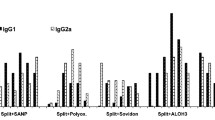Summary
The protective capacities of IgM and IgG immunoglobulins from fractionated human or mouse sera were investigated in tests with tick-borne encephalitis virus. Mice were resistant to challenge with tick-borne encephalitis virus if previously inoculated with specific immunoglobulins but not nonspecific immunoglobulins. The protective ability of IgM, whether derived from mouse or human sera, was only about 1/40 of that of IgG preparations adjusted to the same haemagglutination inhibition or neutralising titres.
Zusammenfassung
Fraktionen von IgM und IgG aus Menschen-und Mäuseserum wurden auf ihre Schutzwirkung gegen die durch Zecken übertragbare Enzephalitis untersucht. Mäuse konnten durch spezifische Immunglobulinklassen gegen Enzephalitis geschützt werden, wenn die Immunglobuline vor der Infektion gegeben wurden. Unspezifische Immunglobuline waren wirkungslos. Dabei war die Schutzwirkung von IgM nur 1/40 der von IgG-Präparationen des gleichen Hämagglutinationshemmungs-bzw. Neutralisationstiters.
Similar content being viewed by others
Literature
Wiedermann, G., Reinhardt, R., Kunz, Ch. Antikörperbildung bei Frühsommermeningoenzephalitis. Zbl. Bakteriol. (Orig. A) 189 (1963) 15–25.
Kunz, Ch., Hofmann, H. Die Frühdiagnose der Frühsommermeningoenzephalitis (FSME) im Hämagglutinationshemmungstest durch Behandlung des Serums mit 2-Mercaptoäthanol. Zbl. Bakteriol. (Orig. A) 218 (1971) 273–279.
Kunz, Ch. Die Frühsommermeningoenzephalitis (FSME) in Österreich und ihre Verhütung. Acta Med. Austr. 4 (1977) 90–92.
Clarke, D. H., Casals, J. Techniques for hemagglutination and hemagglutination inhibition with arthropod-borne viruses. Am. J. Trop. Med. Hyg. 7 (1958) 561–573.
Frisch-Niggemeyer, W. Rapid separation of immunoglobulin M from immunoglobulin G antibodies for reliable diagnosis of recent rubella infections. J. Clin. Microbiol. 2 (1975) 377–381.
Hubinger, M. G., Hofmann, H., Krausler, J. Das Überdauern von Antikörpern gegen das Frühsommermeningoenzephalitis (FSME) Virus beim Menschen. Zbl. Bakteriol. (Orig. A) 213 (1970) 145–151.
Frisch-Niggemeyer, W., Heinz, F., Stemberger, H. Eine schnelle und verläßliche Methode zur Erkennung frischer bzw. älterer Infektionen mit Rubella-Virus. Immun. Infekt. 2 (1974) 231–237.
Author information
Authors and Affiliations
Rights and permissions
About this article
Cite this article
Hofmann, H., Frisch-Niggemeyer, W. & Kunz, C. Protection of mice against tick-borne encephalitis by different classes of immunoglobulins. Infection 6, 154–157 (1978). https://doi.org/10.1007/BF01641903
Issue Date:
DOI: https://doi.org/10.1007/BF01641903




